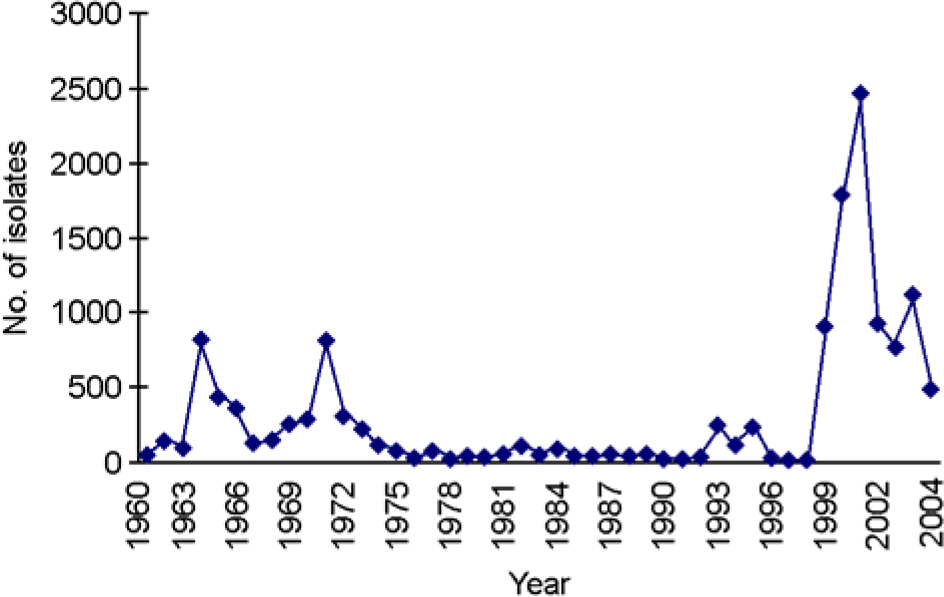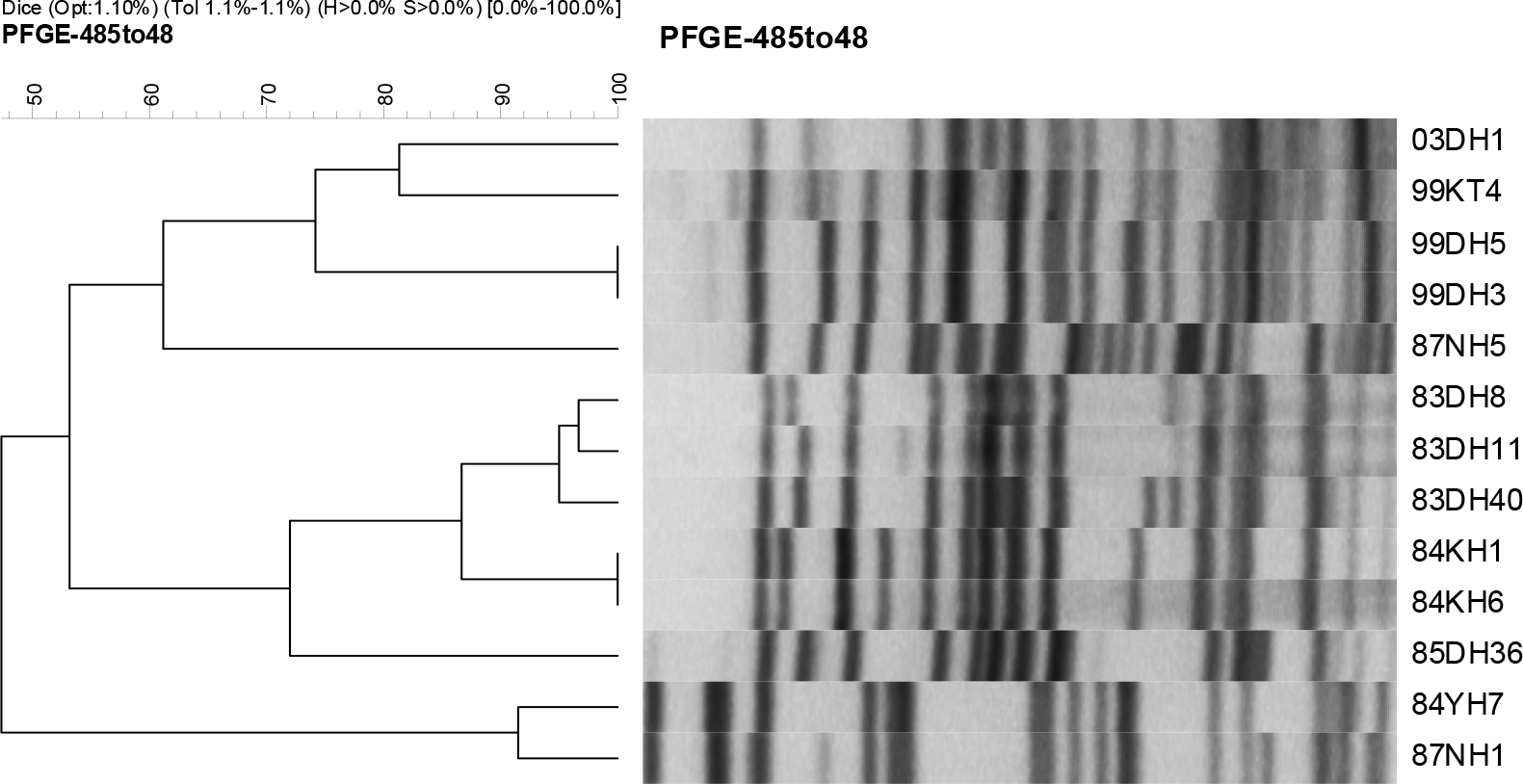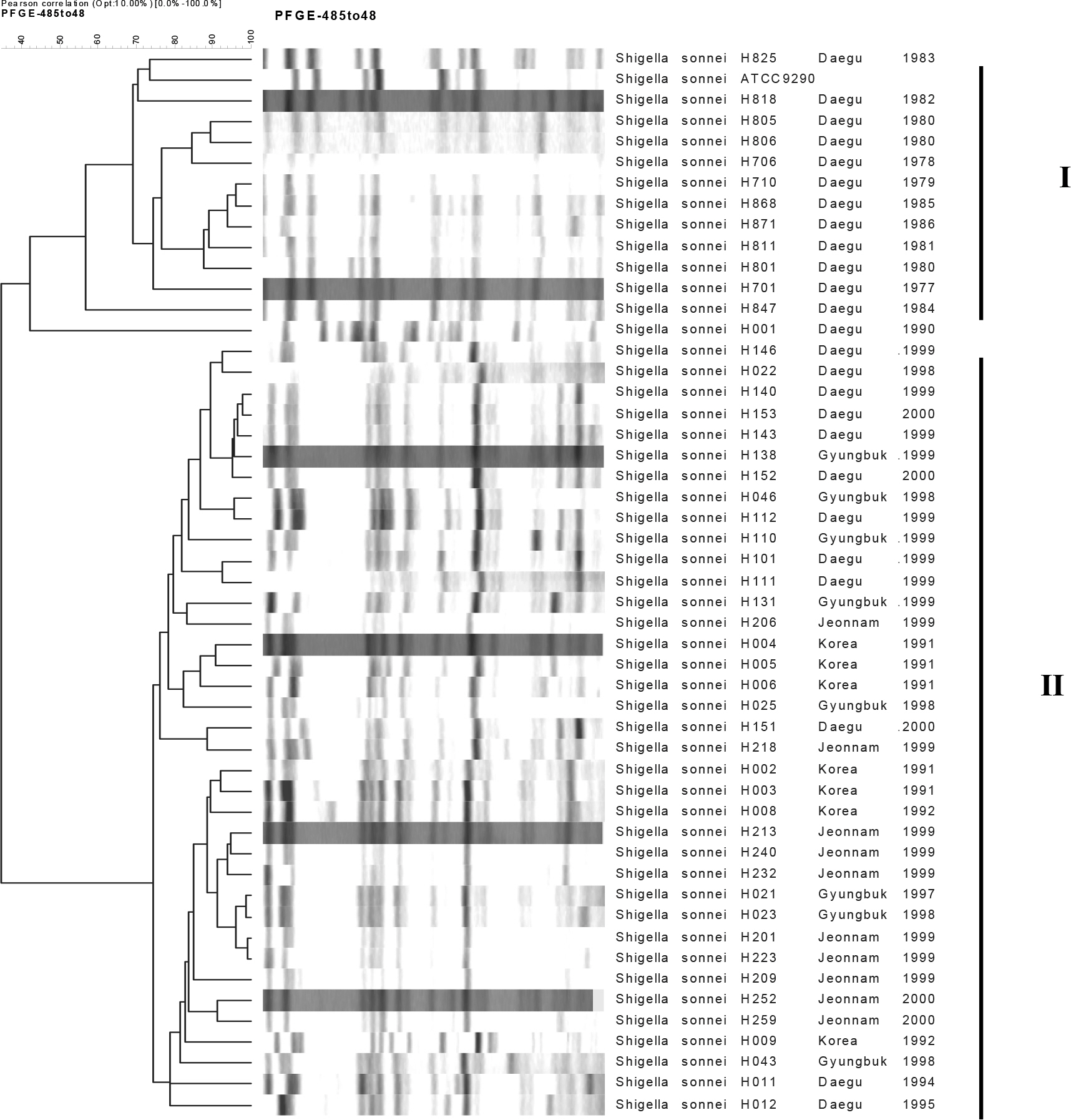Epidemiology of Shigellosis in Korea
- Affiliations
-
- 1Department of Microbiology, Kyungpook National University School of Medicine, Daegu 700-422, Korea. syseol@knu.ac.kr
- KMID: 2055009
- DOI: http://doi.org/10.4167/jbv.2006.36.2.41
Abstract
- Shigellosis is an acute diarrheal disease caused by bacteria of the genus Shigella. Following the occurrence of a large outbreak of shigellosis as well as sporadic cases since 1998, shigellosis has been a major health problem in Korea. There have been major changes in epidemiology during the last five decades concerning shigellosis in terms of total incidence of shigellosis, prevalence of certain serogroups, selection of specific clones, and introduction of new Shigella clones. S. dysenteriae was the most prevalent species until the early twentieth century, S. flexneri was the most prevalent until the late 1980s, and S. sonnei has been the most prevalent since 1990. Diverse serotypes of S. dysenteriae (4 serotypes), S. flexneri (8 serotypes), and S. boydii (4 serotypes) were found during the Korean War and many of these Korean endemic Shigella strains circulated in the community until the late 1970s. However, the endemic strains of S. dysenteriae, S. boydii, and S. sonnei disappeared in the late 1980s. A new clone of S. sonnei that was introduced between the late 1980s and the early 1990s was responsible for a large proportion of shigellosis in recent years. S. flexneri serotype 4a was the most frequently found during the Korean War and then the incidence of S. flexneri 2a gradually increased with time. S. flexneri isolates detected from 1991 to 1997 were all serotype 2a. However, the diverse clones of S. flexneri reemerged in Korea since 1999. It has not been determined whether the S. flexneri strains from the 2000s were the descendants of the Korean endemic strains or imported new strains, but the PFGE patterns were different between S. flexneri strains from the 1980s and 2000s. The widespread of new S. sonnei strains and the persistence of S. flexneri strains are responsible for the endemicity of shigellosis in Korea.
Keyword
MeSH Terms
Figure
Cited by 4 articles
-
In vitro Activities of Mecillinam Against Clinical Isolates of Enterobacteriaceae
Chang-Ki Kim, Jong Hwa Yum, Sang-Guk Lee, Yangsoon Lee, Jun Yong Choi, June Myung Kim, Kyungwon Lee, Yunsop Chong
Infect Chemother. 2009;41(3):174-180. doi: 10.3947/ic.2009.41.3.174.Trends in Childhood Bacterial Infectious Diseases in the Republic of Korea
Young June Choe, Hoan Jong Lee
Infect Chemother. 2011;43(6):468-473. doi: 10.3947/ic.2011.43.6.468.Infection of Extended-Spectrum β-Lactamase Producing Shigella flexneri in Children Attending a Childcare Center in Korea
Eun Woo Nam, Kun Song Lee, Junyoung Kim, Cheon Kwon Yoo
Pediatr Infect Vaccine. 2016;23(3):223-228. doi: 10.14776/piv.2016.23.3.223.History and Epidemiology of Bacillary Dysentery in Korea: from Korean War to 2017
Hyunjoo Pai
Infect Chemother. 2020;52(1):123-131. doi: 10.3947/ic.2020.52.1.123.
Reference
-
References
1). Ahn D, Chun D. Studies on Shigella isolated in Taegu area in Korea. Korean Choong Ang Med J. 3:265–270. 1962.2). Ahn DH, Lee HS. Types of Salmonella and Shigella isolated from patients in Taegu area in 1971. Korean Choong Ang Med J. 21:433–436. 1971.3). Ashkenazi S. Shigella infections in children: new insights. Semin Pediatr Infect Dis. 15:246–252. 2004.4). Barrett-Connor E, Connor JD. Extraintestinal manifestations of shigellosis. Am J Gastroenterol. 53:234–245. 1970.5). Bopp CA, Brenner FW, Wells JG, Strockbine NA. Escherichia, Shigella, and Salmonella. pp. p. 459–474. In. Manual of clinical microbiology. 7th ed. Murray PR, Baron EJ, Pfaller MA, Tenover FC, Yolken RH, editors. American Society for Microbiology;Washington, D. C.: 1999.6). Brenner DJ, Fanning GR, Miklos GV, Steigerwalt AG. Polynucleotide sequence relatedness among Shigella species. Int J Syst Bacteriol. 23:1–7. 1973.7). Brenner DJ, Fanning GR, Skerman FJ, Falko WS. Polynucleotide sequence divergence among strains of Escherichia coli and closely related organisms. J Bacteriol. 109:953–965. 1972.8). Cho NK, Chun D. Types and antimicrobial drug resistance of Salmonella and Shigella isolated in Taegu area in 1979. Korean Choong Ang Med J. 39:5–8. 1980.9). Choi JD, Lee YT, Jung TH. Biological characteristics of the Shigella species isolated from various areas in Korea, 1985. J Korean Soc Microbiol. 22:79–94. 1987.10). Chun C. Clinical studies on enteric pathogens particularly Shigella and Salmonella and intestinal protozoa in Korea. Theses Coll Seoul Nat Univ. 1959.11). Chun D, Kim C, Ahn D, Lee J. Studies on Salmonella and Shigella isolated in Taegu area in Korea. Korean Choong Ang Med J. 5:249–254. 1964.12). Chun D, Park JW, Suh SI, Cho DT, Seol SY, Lee YC. Prevalence and drug resistance of Shigella in Taegu area of Korea. J Korean Soc Microbiol. 21:461–471. 1986.13). Chun D. A review of Salmonella and Shigella in Korea. Endemic Dis Bull Nagasaki Univ. 6:125–138. 1964.14). Chun D. Classification of dysentery bacilli and their prevalence in Korea. J Korean Med Ass. 13:704–710. 1970.15). Du Pont HL, Levine MM, Hornick RB, Formal SB. Inoculum size in shigellosis and implications for expected mode of transmission. J Infect Dis. 159:1126–1128. 1989.16). Flexner S. On the etiology tropical dysentery. Bull Johns Hopkins Hosp. 11:231–242. 1900.17). Hale TL. Genetic basis of virulence in Shigella species. Microbiol Rev. 55:206–224. 1991.18). Im Y, Choi K. Studies on the Shigella isolated in southern Korea with reference to non-Shigella strains possessing Shigella antigens. Showa Med J. 20:1–8. 1961.19). Jeong YS, Lee JC, Kang HY, Yu HS, Lee EY, Choi CH, Tae SH, Lee YC, Cho DT, Seol SY. Epidemiology of nalidixic acid resistance and TEM-1- and TEM-52-mediated ampicillin resistance of Shigella sonnei isolates obtained in Korea between 1980 and 2000. Antimicrob Agents Chemother. 47:3719–3723. 2003.20). Joklik WK, Willett HP, Amos DB, Wilfert CM. Zinsser Microbiology. pp. p. 556–559. 20th ed.Appleton & Lange;Connecticut: 1992.21). Kim KS, Oh JY, Jeong YW, Cho JW, Park JC, Cho DT, Lee JC. Epidemiological typing and characterization of dfr genes of Shigella sonnei isolates in Korea during the last two decades. J Microbiol Biotechnol. 12:106–113. 2002.22). Kim S, Kim J, Kang Y, Park Y, Lee B. Occurrence of extended-spectrum β-lactamases in members of the genus Shigella in the Republic of Korea. J Clin Microbiol. 42:5264–5269. 2004.23). Lee JC, Oh JY, Kim KS, Jeong YW, Cho JW, Park JC, Seol SY, Cho DT. Antimicrobial resistance of Shigella sonnei in Korea during the last two decades. APMIS. 109:228–234. 2001.24). Levine MM. Shigellosis. pp. p. 340–344. In. Hunters tropical medicine. 7th ed. Strickland GT, editor. (Ed),. WB Saunders Co;Philadelphia: 1991.25). Mammina C, Pontello M, Dal Vecchio A, Nastasi A. Shigella sonnei Working Group. Identification of Shigella sonnei biotype g isolates carrying class 2 integrons in Italy (2001 to 2003). J Clin Microbiol. 43:2467–2470. 2005.26). McIver CJ, White PA, Jones LA, Karagiannis T, Harkness J, Marriott D, Rawlinson WD. Epidemic strains of Shigella sonnei biotype g carrying integrons. J Clin Microbiol. 40:1538–1540. 2002.27). Nastasi A, Pignato S, Mammina C, Giammanco G. rRNA gene restriction patterns and biotypes of Shigella sonnei. Epidemiol Infect. 110:23–30. 1993.28). National Institute of Health in Korea. 21 March 2006, posting date. The annual frequency of shigellosis in Korea [Online.]. http://dis.cdc.go.kr/statistics/Statistics_Disease_Year.asp.29). National Institute of Health in Korea. Recent trends in national notifiable diseases occurrence based on the data of 2003. Communicable Disease Monthly Report. 15:129–137. 2004.30). National Institute of Health in Korea. Recent trends in national notifiable diseases occurrence in 2004. Communicable Disease Monthly Report. 16:121–131. 2005.31). National Institute of Health in Korea. Trends in national notifiable diseases occurrence in 2002. Communicable Disease Monthly Report. 14:295–305. 2003.32). Niyogi SK. Shigellosis. J Microbiol. 43:133–143. 2005.33). Ochman H, Whittam TS, Caugant DA, Selander RK. Enzyme polymorphism and genetic population structure in Escherichia coli and Shigella. J Gen Microbiol. 129:2715–2726. 1983.34). Oh JY, Yu HS, Kim SK, Seol SY, Cho DT, Lee JC. Changes in patterns of antimicrobial susceptibility and integron carriage among Shigella sonnei isolates from southwestern Korea during epidemic periods. J Clin Microbiol. 41:421–423. 2003.35). Pai H, Choi E, Lee H, Hong JY, Jacoby GA. Identification of CTX-M-14 extended-spectrum β-lactamase in clinical isolates of Shigella sonnei, Escherichia coli, and Klebsiella pneumoniae in Korea. J Clin Microbiol. 39:3747–3749. 2001.36). Park SH. Studies on Shigella isolated during recent twenty months and changes of those antibiotics susceptibility patterns for last twenty years. J Korean Soc Microbiol. 16:1–5. 1981.37). Seol SY, Lee SH, Kim JW. Classification of Shigella R plasmids by incompatibility. J Korean Soc Chemother. 6:27–35. 1988.38). Seol SY, Suh MH, Lee YC. Antimicrobial drug resistance and R plasmids of Shigella isolated in Taegu area during 1982. J Korean Soc Chemother. 1:249–254. 1983.39). Seol SY. Types and antimicrobial drug resistance of Shigella isolated in Taegu area in 1980. Kyungpook Univ Med J. 21:9–13. 1980.40). Shiga K. Observation on the epidemiology of dysentery in Japan. Philippine J Sci. 1:485–500. 1906.41). Shin HS, Oh SH. A study on changing patterns of Shigella spp. by years. J Korean Soc Microbiol. 22:453–462. 1987.42). Veron M, Le Minor L. Nutrition and taxonomy of Enterobacteriaceae and related bacteria. II. General results and classification. Ann Microbiol. 126B:111–124. 1975.43). Vila J, Gascon J, Abdalla S, Gomez J, Marco F, Moreno A, Corachan M, Jimenez de Anta T. Antimicrobial resistance of Shigella isolates causing traveler's diarrhea. Antimicrob Agents Chemother. 38:2668–2670. 1994.44). Zimmerman LE, Cooper M, Graber CD. Bacteriologic studies in an epidemic of bacillary dysentery in Korea; serotypes of Shigella and Salmonella recovered and bacteriologic response to sulfadiazine, chloramphenicol, terramycin, aureomycin and streptomycin. Am J Clin Pathol. 22:549–557. 1952.45). Zimmerman LE. Some experiences with enteric diseases in Korea. Am J Public Health. 43:279–284. 1953.
Article
- Full Text Links
- Actions
-
Cited
- CITED
-
- Close
- Share
- Similar articles
-
- Reversible Diffuse Brain Edema in Acute Encephalopathy with Shigellosis
- Epidemiological Characteristics of Imported Shigellosis in Korea, 2010–2011
- A Epidemic Survey of the Shigellosis in Jeju Island during the First Half of Year 2000
- The Epidemiological Characteristics of a Shigellosis Outbreak (1998) in Wonju City, Kangwon-Do
- Epidemiological Characteristics of Shigellosis in Jeju Island in 2003




